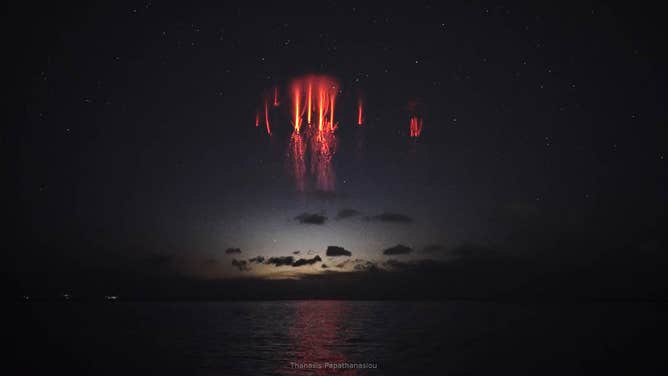NASA wants your help to uncover mysteries behind bright flashes in the sky called ‘sprites’
NASA has created an image database of sprites and other TLEs. Someone who thinks they captured one on camera can submit the images at Spritacular.org, including details on when and where it was recorded.

Red sprites formed above thunderstorms in the southeast Aegean Sea, as captured from the eastern suburbs of Athens, Greece on December 4, 2021. (Credits: Thanasis Papathanasiou)
(Thanasis Papathanasiou)
It might sound like NASA is investigating another UFO sighting with its latest call for citizen scientists' help, but the mysterious bright flashes known as "sprites" are a weather-related phenomenon.
Sprites are a form of Transient Luminous Event or TLE and are often associated with thunderstorms. These bright light flashes happen above the storm in Earth's upper atmosphere about 50 miles up, producing quick flashes of reddish light in various shapes.
According to NASA, it wasn't until a 1989 accidental photograph of a sprite did scientists have tangible evidence for the flashes above thunderstorms.
Precisely what causes TLEs is still a mystery. Sprites were named for the fairy-like creatures in European folklore. Sticking with the theme, other TLEs are called ELVES, Halos, Blue Jets and Gigantic Jets.

A red sprite (indicated by white arrow) above a thunderstorm was captured by members of Expedition 44 Crew aboard the International Space Station on Aug. 10, 2015. (Credits: NASA)
To understand these quickly disappearing flashes, NASA announced a new citizen science project called Spritacular to crowdsource more information about the electrical phenomena.
Spritacular principal investigator and NASA space physicist Burcu Kosar and his coinvestigators have created an image database of sprites and other TLEs. Someone who thinks they captured one on camera can submit the images at Spritacular.org, including details on when and where it was recorded.
Scientists will then review the photos. The images could lead to scientific discoveries where the photographer will be included as a coauthor on published studies.
"People capture wonderful images of sprites, but they're shared sporadically over the internet, and most of the scientific community is unaware of these captures," Kosar said in a news release. "Spritacular will bridge this gap by creating the first crowdsourced database of sprites and other TLEs that is accessible and readily available for scientific research."
Since launching the website, NASA has received reports of sprite sightings from around the world, including Texas, Hungary, Puerto Rico and Greece.